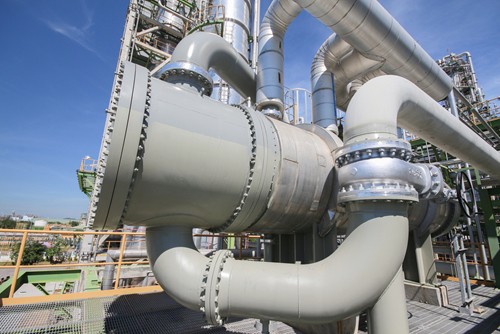Shell and tube heat exchangers are an integral part of many operations. The product flowing through the exchanger, such as dairy, food, or pharmaceuticals, will eventually be in the hands of customers who rely on consistent quality for their health and well-being. For this reason, it is crucial the exchanger is the best one for the job.
Manufacturers need to choose the right style of shell and tube heat exchanger. Different processes and industries have different requirements for their equipment. Because of this, customizing a shell and tube heat exchanger takes expertise from both the supplier and the buyer of the equipment. A lot that goes into fabricating a heat exchanger and taking all pertinent items into consideration is essential during the design phase.
The Shell
Perhaps the most recognizable part of the shell and tube heat exchanger is the shell itself. There are many different options for the shell design, including one-pass shells, two-pass shells, double split flows, divided flows and cross flows. These are all classified as different standards with the Tubular Exchanger Manufacturers Association. There are also several streams within the shell that need to be taken into consideration when designing it.
There are many different materials that shells can be made from. The materials should be resistant to corrosion and sturdy enough to encase the tubes and the high-pressure processes that will occur within. Carbon steel is a common material used for shells, as is stainless steel. Stainless steel is highly resistant to many forms of corrosion, making it a preferred material for many manufacturers.
It’s important to understand what liquid will be flowing through the shell side. Knowing the liquid that will be used will help to determine the material, as the metal chosen should not react with the fluid used. Viscous fluids can be used either on the tube side or the shell side. However, many exchangers that use viscous liquids on the shell side experience vibrations, which puts the equipment at risk of damage and maldistribution.
Tubes and Tube Sheets
There are three types of tube sheet designs. A fixed tube sheet has tubes that run from one end of the shell to the other and is welded to the shell. A U-tube heat exchanger only requires one tube sheet because the tubes leaving the tube sheet are bent at the end of the exchanger and returned to the same sheet. The third type is the floating head. This requires two tube sheets; one, which is fixed to the shell, and a second, which is located at the other end but is not fixed, allowing for tube expansion.
There are many factors to consider when choosing between these three. One of them is cost. The u-tube tube sheet is likely the least expensive as only one tube sheet and channel is required. The fixed tube sheet is more expensive but gives you more options for more viscous fluids. Finally, the floating head tube sheet is the costliest, as it has the most complex design.
However, while cost plays an important part in the decision-making process, it cannot be the only factor. It is crucial that the tubes and tube sheets be cleaned and maintained to prevent breaks, leaks and fouling. The fixed tube sheet’s tubes can be accessed for cleaning (with cleaning rods or pressurized water), but the tube bundle cannot be removed from the shell, making cleaning difficult. On the other hand, the U-tube and floating head designs allow for the bundle to be removed, so cleaning is easier.
Learn more about maintaining your shell and tube heat exchanger.
More from the Enerquip Blog
- Difference Between Parallel Flow, Counter Flow, and Crossflow Heat Exchangers
- Breaking the Heat Exchanger Code
- 7 Ways Shell & Tube Heat Exchangers Outperform Plate & Frame
- Decoding the Delicate Balance of Sizing Shell and Tube Heat Exchangers
- Insulation Jackets: Enhancing Efficiency and Performance of Shell and Tube Heat Exchangers
- Discover the Hidden Brilliance of Metal Surfaces: Unleash the Power of Electropolishing

